What's Happening

Technology and Graduation Rate: A Direct Correlation
Another interesting article outlining another benefit of technology in the classroom; properly implemented technology can help those students who may otherwise fall through the cracks move through to graduation.
Read more...
The Beginner's Guide to Competitive Gaming in Schools
Jason Cross, our director of education, has been published again on Edudemic. Today, we learn about the rise of competitive gaming in schools...just another example of the seamless integration between technology and education.

iPads Allow Kids with Challenges to Play in High School's Band
One of the most beneficial outcomes that teachers and administrators of our Smart Schools have noticed is the significant impact a 1:1 deployment can have on special education and students with various challenges and learning disabilities. Here is a great example of technology serving as a vehicle for students with challenges to achieve and succeed.
Read more...
App Smashing: Combining Google Drive, iTunes U and Apps in the Classroom
Jason Cross, iSchool Campus' director of education, outlines the benefits of "App Smashing" on edudemic.com.
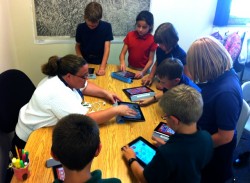
Legacy Academy, one of iSchool Campus' first 'Smart Schools' honored by Pearson School Services
Legacy Academy in Elizabeth, Colorado became one of iSchool Campus' first whole-school deployments in 2010. Since then, Legacy has fully embraced technology and innovative approaches to education and learning. Legacy has also seen significant increases in student achievement in reading and math. We wholeheartedly agree that Legacy Academy is a 'beacon of education.'
Read more...
U.S. official pushes for more education technology in Utah schools
Libby Doggett, head of the Obama Administration's early childhood education office, toured Granite School District's preschool program this week, stressing the importance of technology in education, even for preschoolers.
"Devices not only bring the world to our students … . They can bring what children create to the world."
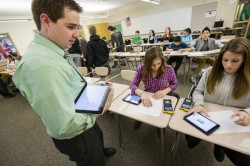
North Davis Junior High students spend the school day with iPads
North Davis Junior High, located in Clearfield, Utah is one of iSchool Campus' most recent full-school 1:1 deployments, and the largest fully-integrated Smart School in the State. North Davis partnered with the Governor's Office of Economic Development, the Utah State Office of Education, Davis School District and the GEAR UP program through Utah State University to make this revolutionary approach to education a reality for their students. Learn more here...

This Facebook Idea Belongs in Schools
Most schools that I have visited struggle with social media, and its appropriate place in schools. It is so easy for one thing to go wrong and thousands of people to see it and react. This is risk that most schools are just not willing to take. When analyzing the problem, we can probably identify lots of ways that social media can be negative in the classroom. Will there ever be a time when students are respectful enough to use social media in a powerful way to change education?
Facebook is moving into some new digs in New York. All of the images of the amazing office space are really fun to look at, however one stood out from the others to me. A blank wall that says "write something...". Schools are full of blank walls and this might just be an amazing trick to teach students about social media.
By creating a wall in your school where students have the ability to write on the wall, you can teach the expectations of social media. The wall is very similar to how social media actually works, with one exception. The perceived privacy that students struggle with can be taught visually. When somebody writes on this wall, they are exposing their thoughts to whomever walks by. Write something negative on this wall, and the entire school can see. Write something uplifting on this wall and you can brighten someone's day. Use this wall to educate and you have a large audience of willing learners.
Although it is just paper and gypsum, the reality is that students can visually see how their ideas impact the group. Make the parallels to the real Facebook wall and students should be able to visually see how their comments on websites can impact the lives of anybody that walks by. This seems to be one of the first steps of teaching solid digital citizenship skills to today's 21st century students.
-Jason Cross-
The SAMR Model/Gartners' Hype Cycle and the Phases of First Year Teaching
 As schools make the move to a digital classroom there is a lot at stake. There also exists a complex situation where many different types of classroom research converge upon implimentation. Schools often look to the SAMR model created by Dr. Ruben Puentedura for some guidance because they want the technology to redefine the education process. This model is the cornerstone to understanding the process of moving from classroom technology being something that substitutes for what we already can do, to the type of tool that transforms education. Schools that integrate technology sometimes become disenchanted by the process. After a few months the new wears off and the new equipment doesn't seem to have any added value. Teachers then put it aside and speak to all of the distractions that it has created for them.
As schools make the move to a digital classroom there is a lot at stake. There also exists a complex situation where many different types of classroom research converge upon implimentation. Schools often look to the SAMR model created by Dr. Ruben Puentedura for some guidance because they want the technology to redefine the education process. This model is the cornerstone to understanding the process of moving from classroom technology being something that substitutes for what we already can do, to the type of tool that transforms education. Schools that integrate technology sometimes become disenchanted by the process. After a few months the new wears off and the new equipment doesn't seem to have any added value. Teachers then put it aside and speak to all of the distractions that it has created for them.
Pure and simple, schools struggle to get past the Augmentation phase of the SAMR model. It is past this phase where the technology actually becomes valuable to the education process, but there seems to be a wall right in the center of this model. It is at the point where the things being done in the classroom could not have been done without technology. In order to get past this barrier we need to understand some other key forces at work when implementing a large scale technology plan.
 Gartner Inc. has created something called the Hype Cycle. The Hype Cycle helps us to discern all of the hype around the implementation of new technology. It is designed to give us a "view of how a technology or application will evolve over time, providing a sound source of insight to manage its deployment within the context of your specific business goals." (More Here) The model essentially starts with a "Technology Trigger", and I believe that most schools are at this point. We are only years away from technology being a dominate force in the classroom. Once the trigger has been pressed you have a period of inflated expectations as stakeholders become very excited about what the technology can do for your school. Those expectations are usually abruptly moved to a period of disillusionment as things don't seem to be moving the way we imagined in our head. From there we have a period of enlightenment and eventually a plateau of productivity. When you line the Hype Cycle on top of the SAMR Model, you begin to see why so many schools have a difficult time moving past the Augmentation phase.
Gartner Inc. has created something called the Hype Cycle. The Hype Cycle helps us to discern all of the hype around the implementation of new technology. It is designed to give us a "view of how a technology or application will evolve over time, providing a sound source of insight to manage its deployment within the context of your specific business goals." (More Here) The model essentially starts with a "Technology Trigger", and I believe that most schools are at this point. We are only years away from technology being a dominate force in the classroom. Once the trigger has been pressed you have a period of inflated expectations as stakeholders become very excited about what the technology can do for your school. Those expectations are usually abruptly moved to a period of disillusionment as things don't seem to be moving the way we imagined in our head. From there we have a period of enlightenment and eventually a plateau of productivity. When you line the Hype Cycle on top of the SAMR Model, you begin to see why so many schools have a difficult time moving past the Augmentation phase.
In the early going, administrators, and school staff are excited by the technology. They have very little problem substituting it for things they already do in the classroom. They become very excited about what the technology can do and they begin to augment their instruction with applications while using internet resources. At first the impact is significant because there is an immediate increase of engagement occurring. As these processes are beginning, teachers then realize the need for pre-requisite skills to be taught, lesson plans become more complicated and the early results are less that enticing. Students will become distracted by the technology because they are still using it as a consumer product, and the connection has not yet been made to the electronic device becoming a creative tool for critical thinking. This causes many teachers to abandon the technology, leaving administrators that still believe in the system to struggle to find the buy in needed to innovate in the classroom.
There are other forces at work as well. Integrating technology in the classroom is tricky because of the before mentioned pre-requisite skills. Not only by the teacher, but also by the student. We make a common mistake of believing that students already have all the technology skills to perform with it in the classroom. It simply isn't true. In most of our past educational experiences, we can think of a time where we were given a 30 minute lesson on how to fill out a bubble sheet test. Technology needs the same attention as we give to the number two pencil, coloring inside the lines. It is because of these missing pre-requisites that most teachers given new technology become like first year teachers again. In 1990 the California Department of Education published research on the Phases of first-year teachers and their attitude towards teaching. I believe this model can be applied to the classroom attitudes towards technology. Not only by the teacher, but also by the students in many cases.
At first, just as with the Hype Cycle there is extreme excitement over the anticipation of teaching and learning with the new devices. That quickly turns to survival as the pre-requisite knowledge starts to become an factor in using them. Teachers are having to plan differently, learn new apps, dissever new lesson plans and before long they are in a period of disillusionment. Students are learning new classroom procedures, coping with an open world of information and in general just trying to find ways to remain as productive as they were prior to the technology. In most cases, the students begin to rapidly lose interest in the new technology because in these early phases it operates just like a text book and paper. It doesn't allow them to be more creative, it represents exactly the same education they were already getting with much of the same results. Students become disillusioned because they want this device to be their Magic Mystery Box. They want to use it to become creative and build things of value to offer the world. In the early days the box is opened and it becomes just another thing they have to deal with.
There is some great news at the end of this story of struggle however. The teacher that sticks with it finds rewards in the end. All of these pieces of research predict it. In the later phases of the SAMR model the technology does things for the classroom that were impossible without it. I have seen this in some of the schools I visit on a regular basis. They do things in these schools that are not possible without technology. I have visited schools before where students are engaged in activities that are so advanced, being creative is just a way of life. The Hype Cycle tells us that eventually classrooms will make it to the Slope of Enlightenment that leads to the Plateau of Productivity. It is at these phases, after all of the bumps in the road have been dealt with that understating occurs. Teachers know how to use the technology to the best of their ability and students are starting to use it for moving beyond the 20th century. And finally when we look at the Phases of First Year Teachers' we see that hard work starts to rejuvenate the teacher. They are able to reflect on their past efforts and usually are in anticipation of becoming more productive in the technology classroom.
So the lesson is, stick with it.
-Jason Cross-
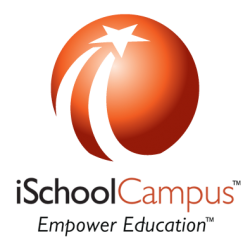
The Golden Circle Applied to the Classroom
Teachers in classrooms are always looking for an edge to help them connect with students. Especially those hard to reach students that stick out in the classroom like a stray piece of broccoli in your teeth after a nice meal. If you have ever had a successful lesson where the students left energized and excited about your lesson, you know what an amazing experience it is. Not only for your students, but for your sanity as an educator. It is those moments of complete student engagement where everything comes together and you are glad you chose education as your profession.
In the process to try and diagnose a solution to helping students take ownership of their own learning, we have looked towards learning styles, engagement strategies and a variety of classroom modifications for answers. We bring in new curriculums, take students outside and invent amazing games in an effort to have more excellent moments in the classroom. Despite our efforts students sometimes are tuned out for our best designed lessons, and those teacher pleasers are often just going through the motions. How to we capture the minds of students with a variety of backgrounds, needs and ability levels?
The answer might not be simple, but we can start by looking to the marketing world for help. After all, these are the people that can get me to buy a new iPad when the one I already does everything I need. We have all been sitting on the couch after a big meal, turned on the television to see an add for a juicy hamburger and thought, "I am so full, but that does look good". Marketing professionals have mastered what drives our decisions and we can learn from them by discovering how they tap into the human brain to produce feeling. When looking to get a group of students engaged, we must look at what motivates their decision making. We have to tap into the key motivator that will create buy in for our lessons.
Simon Sinek created something called the Golden Circle as a way of explaining marketing behaviors. In his Ted talk which explains the principals of the Golden Circle, Mr. Sinek uses the example of Apple Computers to explain why they have been so successful in influencing people to buy anything that they make. I have posted the Ted talk below, and I recommend taking a look at it. If you watch his ideas with your classroom in mind, you will discover that most of us have been going about our education efforts from the outside in, rather than from the inside out. We are not in touch with the part of the brain that makes decisions, therefore we are not getting our students to actively find a need to be a part of what is happening in the classroom. Most students just don't "feel" like participating. And we might not have been giving them a reason to.
This is a quick explanation of the Golden Circle, however please watch the Simon Sinek video, and maybe even read his book, because he is the expert on this. Here is the quick:
Here is a quick summation of Simon Sinek's explanation of the Golden Circle. The inner most part of the circle is the WHY portion. Why we do things is a process of our Limbic brains that control emotion and feeling. The next circle is HOW, and the how section is made up of the decisions that control our ability to get to the result. The outer most circle is the WHAT section. What we do is controlled by the Neocortex, and it involves rational thought. The principal of the Golden Circe is that we most often are working from the WHAT section towards the WHY section. You usually start a lesson plan with what you would like the students to do. Often we utilize this as our goal statement for the classroom. As an example we state: Given the information in the book, you will be able to answer the following questions with 80% accuracy. This is working from the rational Neocortex part of our brain, which does not control decision making towards our Limbic brain. In many cases we feel that by putting this clear goal not he board our students will have a greater chance of success. However many teachers will probably agree with me that we tend to get the same disconnected students as before. This is because we need to tap into the Limbic brain, the part of the brain that controls decision making. This is the part of the brain that "feels" good or bad about something and tends to control our efforts from behind the scene. So in order to tap into the part of our brain that will get us motivated and engaged, we have to connect with WHY we are embarking on the lesson that we are on. It gets even more complex as Simon Sinek also ties this to the Law of Diffusion of Innovation, which can also be tied into the classroom, but would take an entire blog post of its own.
In order to use this principal in your classroom, think about how you present your lessons to the group. Do you explain why students need to learn the lesson, or do you focus your time on what you would like the students to do? If you stay focused on the result, you will not get the engagement back from the students. If you focus on how they are to work on the assignment you will end up with confused looks and students looking around for others to help them "keep up", when in fact they are just not sold on the idea. The answer is to get them to buy into why the content or lesson you are presenting is so important.
Have you ever met a dynamic or engaging teacher? They are often referred to as passionate individuals that are driven by their content. If you think about it in the context of Mr. Sinek's marketing model you will realize that they are all about the WHY. Those teachers are able to create demand for their content because they are so engaged in why it is important. A science teacher that loves science usually has little problem trying to get students to buy into a lesson because they are first explaining WHY that concept is so essential. When you are teaching a lesson, you must make sure that you have a good and valuable reason WHY, to create demand for how and what you will be doing. The results will follow.
It sounds simple really, but I assure you it is a difficult skill to master. When trying to apply this type of thinking to the lesson, you might find that your WHY relates to WHAT you want your outcome to be. Your WHY cannot be "to increase test scores". That is a result, and results do not drive behavior. If you think about this, you will find that most of your lesson plans need modification, or a complete rebuild. You might even find that your curriculum map is needing to be updated because of your need to identify WHY you are teaching a subject. In many cases you might find that assignments have no WHY, or you don't know WHY. If you only know that you are working on a piece of work because it is part of the curriculum, evaluate that work to determine what the specific purpose is. How does the assignment work to bring students to a higher level of understanding. How does that assignment bring them to WHY they are learning. If you can begin to map your material to this concept, you will see students becoming in charge of their own learning because they understand WHY it is important, HOW it needs to be done, and WHAT the outcome should look like.
-Jason Cross-

iSchool Campus Launches New Smart School® in Port Richey, Florida
Florida legislative leaders gather at Dayspring Academy to focus on success of the whole-school technology model and to push for statewide technology programs
Top lawmakers to push for bigger spending on school technology

Bill could mean more tablets, tech in Florida schools
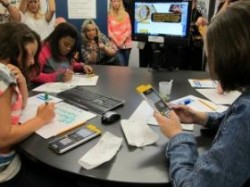
How Florida Lawmakers Want to Help Schools Get Ready for Digital Lessons

Lawmakers to visit digital classrooms in Port Richey

Central Texas elementary school shows improved test scores thanks to iPad deployment
Speegleville Elementary sees significant test score gains; administrators credit iPad deployment, comprehensive professional development and increased student engagement. All these components are key to a successful whole-school technology deployment.

Additional lessons learned from Los Angeles Unified School District's iPad deployment
Los Angeles's massive iPad deployment has received some bad press because advance planning regarding mobile device management was lacking. iSchool Campus deploys comprehensive whole-school solutions and works with schools from start to finish to ensure proper management and support. Here are few more lessons that keep rolling in....
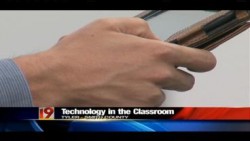
Technology in the Classroom - iSchool Campus in Tyler, TX

Three More Utah Schools Find Cash for Tech Makeover

iSchool Campus Secures Deal To Deploy SmartSchool In Utah Schools

iSchool Campus Wins Bid to Continue Groundbreaking Smart School Technology Program in Utah Public Schools
iSchool Campus™, the leading integrator of SmartSchool™ technology, has been selected by the Utah Governor’s Office of Economic Development (GOED) to continue deploying whole-school technology in Utah public schools through the expansion of the groundbreaking `Smart School Technology Pilot Program.’ The expansion represents the broad scale implementation of leading edge technology utilizing one-to-one mobile devices in the classroom. The iSchool Campus model offers a seamless conduit to advanced digital learning environments that directly speak to the native abilities of today’s students.
Read more...
iSchool Campus Demonstrates "The Future of Education" to National Association of Elementary School Principals

iSchool Campus Receiving Rave Reviews at 13th Annual National Charter Schools Conference

First Idaho Public Smart School Launched
Lieutenant Governor Brad Little, State Senator Dean Cameron, Speaker of the House Scott Bedke and School Officials Gather to Launch One-To-One Technology at Paul Elementary
Public Smart School Program Expands
Utah Speaker of the House Becky Lockhart, Governor’s Office of Economic Development, Educators and State Legislators Gather to Launch Whole School Technology
Crocker Ventures Invests $2 Million in iSchool Campus
Innovative ‘Smart School’ Provider Focuses on Whole-School, One-to-One Deployment of Educational Tools for the Classroom. Investment Designed to Help Transform Classroom Environment, Prepare 21st-Century U.S. WorkforceiSchool Campus today announced that Crocker Ventures has provided a lead investment of $2 million in a board-approved $4 million Series A funding round. Founded in early 2011, iSchool Campus enhances K-12 student engagement and learning by providing a complete “Smart School” system that integrates one-to-one mobile devices, such as the iPad, and a variety of other technology-based teaching tools across an entire school.
Read more...

